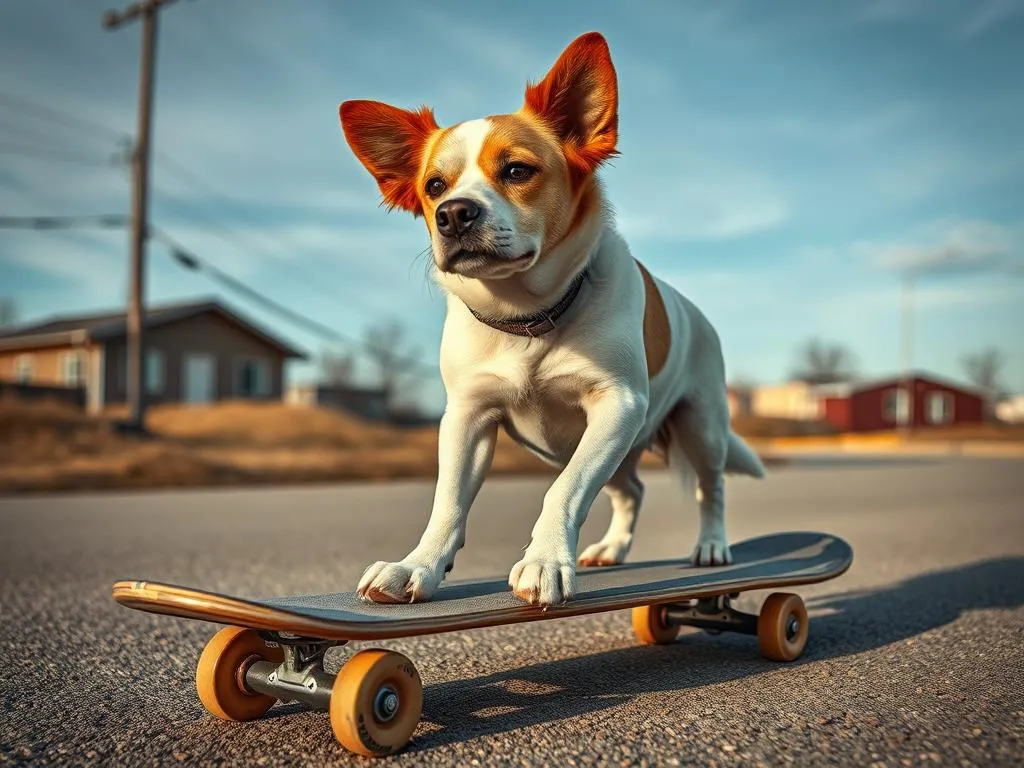
Introduction
Teaching your dog to skateboard can be an incredible bonding experience, providing both mental and physical stimulation for your furry friend. Imagine the joy of seeing your dog glide smoothly on a skateboard, showcasing their skills while having a blast! Beyond the fun, this activity can help strengthen the relationship between you and your dog, building trust and communication.
Positive reinforcement plays a vital role in dog training. By rewarding your dog for their efforts, you create a supportive environment that encourages learning and exploration. In this article, we’ll guide you through the process of teaching your dog to skateboard, covering everything from assessing your dog’s temperament to advanced tricks and tips for success. Let’s get rolling!
Understanding Your Dog’s Temperament
Assessing Your Dog’s Personality
Before you embark on this exciting journey, it’s essential to understand your dog’s personality. Some breeds and individual dogs are more likely to enjoy skateboarding than others. Generally, playful, energetic, and confident dogs are well-suited for this activity. Breeds like Jack Russell Terriers, Border Collies, and Labrador Retrievers often thrive in dynamic environments.
Conversely, if your dog shows signs of nervousness or fear around new objects, they may need extra encouragement and patience. Look for signs such as cowering, excessive barking, or trying to hide. Recognizing these traits will help you gauge your dog’s comfort level as you introduce the skateboard.
Determining Readiness for Skateboarding
Your dog’s age and physical condition play significant roles in determining their readiness for skateboarding. Puppies may be too young, while older dogs may have physical limitations. Generally, dogs aged 1-7 years are in their prime for learning new tricks and participating in physical activities. Additionally, consider your dog’s previous experiences with similar activities. If they have enjoyed other forms of play, like agility training, they may be more open to trying out skateboarding.
Essential Equipment
Choosing the Right Skateboard
Not all skateboards are created equal when it comes to teaching your dog. The right skateboard should be sturdy, wide, and stable. Look for skateboards designed for beginners or those with a wider deck to provide better balance for your dog. A longboard can also be a great option due to its stability and smooth ride.
When selecting a skateboard, consider your dog’s size and weight. A skateboard that is too small may tip easily, while one that is too large can be challenging for your dog to maneuver. Make sure the skateboard can support your dog’s weight comfortably.
Safety Gear
Safety should be a top priority when teaching your dog to skateboard. Protective gear, such as a well-fitted harness and pads for their paws, can prevent injuries. Look for products designed specifically for dogs, ensuring they are comfortable and allow for full range of motion. Remember, a safe training environment will help your dog feel more secure and confident as they learn.
Basic Commands and Skills
Teaching Basic Obedience Commands
Before diving into skateboarding, it’s essential to establish a foundation of basic obedience commands. Commands like “sit,” “stay,” and “come” are crucial for ensuring your dog responds to your cues, especially in potentially distracting environments. Use positive reinforcement techniques, such as treats or praise, to reinforce these commands during training sessions.
Building Confidence on the Board
Familiarizing your dog with the skateboard is the first step to building their confidence. Start by allowing them to sniff the skateboard and explore it at their own pace. Gradually encourage them to place their paws on the board. Use treats and praise to reward their bravery and curiosity. The goal is to create a positive association with the skateboard before moving on to more active training.
Step-by-Step Guide to Teaching Skateboarding
First Steps: Getting Comfortable
Begin your training sessions with short, low-pressure introductions to the skateboard. Allow your dog to explore the skateboard without any pressure to perform. Keep the sessions brief and enjoyable, aiming for 5-10 minutes at a time to prevent overwhelming your dog. Always end on a positive note, regardless of progress.
Encouraging Movement
Once your dog is comfortable with the skateboard, it’s time to encourage movement. Use treats to motivate your dog to push off and move on the skateboard. Start by gently rolling the board forward while your dog is on it, rewarding them with treats and praise for staying on. Gradually increase the distance and speed as your dog becomes more comfortable.
Progressing to Riding
As your dog gains confidence, encourage them to stay on the skateboard while it moves. You can use a leash to guide them gently or encourage them to push off with their back legs. Gradually increase the speed and distance of your sessions, always monitoring your dog’s comfort level and readiness to progress.
Common Challenges and Solutions
Overcoming Fear and Anxiety
Every dog is unique, and some may experience fear or anxiety when introduced to skateboarding. If your dog shows signs of anxiety, such as trembling or trying to flee, it’s crucial to remain patient. Use calming techniques, such as soothing words and gentle handling, to help them feel secure. Gradually expose them to the skateboard, allowing them to take their time.
Dealing with Distractions
Training sessions can be filled with distractions, from other dogs to sudden noises. To manage these distractions effectively, practice in a controlled environment, like your backyard or a quiet park. Gradually introduce your dog to more stimulating environments once they are comfortable on the skateboard.
Addressing Safety Concerns
Safety should always be your top priority. Ensure that the area where you’re training is free from obstacles and hazards. Keep an eye on your dog’s energy levels, and if they seem tired or uninterested, it’s time to call it a day. Recognizing when to stop a training session can prevent injuries and keep your dog motivated.
Tips for Successful Training Sessions
Setting Realistic Goals
When teaching your dog to skateboard, it’s essential to set realistic and achievable goals. Break down the training process into smaller milestones, such as getting your dog to stand on the skateboard or rolling for a short distance. Celebrate each achievement, no matter how small, to keep your dog motivated.
Consistency is Key
Establishing a regular training schedule is crucial for success. Consistency helps reinforce learning and builds a routine for your dog. Aim for daily short training sessions, allowing your dog to practice and improve their skills gradually.
Keeping it Fun
Keeping training sessions fun is vital for maintaining your dog’s interest. Incorporate playtime and breaks into your sessions to keep your dog engaged. Use interactive toys or games to make the experience enjoyable and rewarding for both of you.
Advanced Techniques and Tricks
Skateboarding Tricks for Dogs
Once your dog has mastered the basics of skateboarding, you can introduce fun tricks. Tricks like “jump,” “spin,” or “weave” can add excitement to your sessions. Use positive reinforcement to encourage your dog to learn these new skills.
Building a Skateboarding Routine
Creating a routine that showcases your dog’s skills can be a delightful way to bond and have fun. Incorporate a variety of tricks and movements into a routine that you can perform together. This not only enhances your dog’s confidence but also provides a platform to show off their newfound skills to friends and family.
Participating in Dog Skateboarding Competitions
Skateboarding competitions for dogs have gained popularity in recent years. Participating in these events can be a fun way to challenge your dog and showcase their skills. Research local competitions and consider preparing your dog by practicing specific routines and tricks tailored for the event.
Conclusion
Teaching your dog to skateboard is a rewarding experience that requires patience, consistency, and a lot of love. From understanding your dog’s temperament to overcoming challenges, each step of the journey is essential for success. Remember to celebrate the small victories and enjoy the process of learning together. The joy of seeing your dog skateboarding will create lasting memories and deepen your bond.
FAQs
How old should my dog be to start skateboarding?
Most dogs can begin learning around one year of age, but ensure they are physically fit and comfortable with the activity.
What breeds are best for skateboarding?
Energetic and playful breeds like Jack Russell Terriers, Border Collies, and Labradors often excel at skateboarding.
Is it safe for all dogs to skateboard?
Not all dogs are suited for skateboarding, especially those with physical limitations or anxiety. Always assess your dog’s comfort level and health before starting training.
What if my dog is afraid of the skateboard?
Take your time to introduce the skateboard gradually. Use positive reinforcement and ensure a calm training environment to build your dog’s confidence.
Can I teach my dog tricks while skateboarding?
Absolutely! Once your dog is comfortable on the board, you can introduce fun tricks to enhance their skills and keep the training enjoyable.









